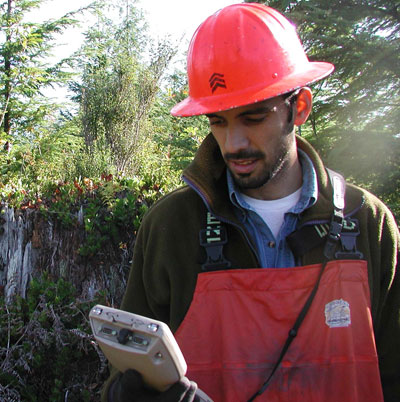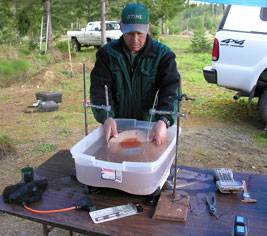|
Facts & Figures: The Stand Management Cooperative
 |
| Mariano Amoroso, ’04, takes tree measurements with a handheld computer at Stand Management Cooperative research plot.* |
-
The Stand Management Cooperative (SMC) is a partnership of forest industry, state, provincial and federal agencies; suppliers and universities who commit resources and expertise to provide a continuing source of high quality information on the long-term effects of silvicultural treatments and treatment regimes on stand and tree growth and development and on wood and product quality. It also provides information on how these treatments affect habitat, carbon balances and biomass for energy.
-
Professor David Briggs, ’80, serves as SMC’s director. Holder of the School’s Corkery Family Chair, Briggs also directs an allied cooperative at SFR, the Precision Forestry Cooperative.
-
SMC’s current membership includes 23 dues-paying land managing organizations, several forestry suppliers and consultants that provide materials and expertise and seven institutions that contribute in-kind scientific and technical assistance. Three universities are included in the membership—UW, Oregon State University and University of British Columbia.
-
A Policy Committee of dues-paying members is charged with establishing the highest possible technical standards in carrying out SMC’s mission. Technical Advisory Committees in silviculture, nutrition, wood quality and modeling comprised of leading scientists develop plans for research projects for approval by the Policy Committee. The nutrition component was a result of the 1991 merger of the Regional Forest Nutrition Research Program (RFNRP), which began at the College of Forest Resources in 1969, into SMC.
-
Over the years, SMC project managers and technicians have helped SMC create and maintain 513 installations in British Columbia, Washington and Oregon, primarily in Douglas-fir and Western Hemlock. The installations, which are tracked in a database, contain 7,139 plots with a variety of treatments. These contain almost 278,723 trees which together have received 1,592,888 measurements. Soil survey data, vegetation surveys and stem section information are also collected.
-
The SMC is currently monitoring 133 Type I, II, III, IV and V installations. The type I, II and III installations, begun in the late 1980s, represent a wide range of site conditions and geographic areas. Each installation contains a series of treatment plots examining a set of thinning, fertilizing and pruning regimes. Thirty-eight Type I installations were established in juvenile plantations before the onset of inter-tree competition. Twelve Type II installations were established in plantations reaching commercial thinning age and assumed to reflect conditions that the Type I plots would eventually achieve. The SMC’s true objective, however, is embodied in the 47 Type III installations, each planted at six planting spacings using common reforestation practices of the late 1980s to early 1990s.
 |
SMC's Bob Gonyea measures acoustic velocity as part of research on evaluating wood quality.** |
-
In collaboration with the USDA Forest Service’s Pacific NW Research Station Genetics Team and Oregon State University’s Northwest Tree Improvement Cooperative, SMC planted six new Type IV installations to examine genetics, vegetation control and spacing on growth and yield and quality. Starting in 2007, SMC has established more than 60 new Type V installations with the objective of improving the ability of managers to predict which sites will respond to fertilization.
-
Among research accomplishments, SMC has sponsored a large study on the processing of plantation Douglas-fir into lumber and veneer that established important linkages among silviculture, log quality and value. It completed studies on modeling branch and crown structure and occlusion after pruning in young Douglas-fir. SMC-ORGANON, a first-phase growth and yield model, was developed in the 1990s based on data sets supplied by members; a phase-two update based on SMC installation data was released in 2005. SMC has also collaborated on the development of a new variant of the CONIFERS model that focuses on growth from planting until about age 15; the results can then be exported to other models to continue growth and yield projections. As the SMC database grows, the models are updated periodically.
SMC celebrates its 25th anniversary in 2010.
* Photo by Bob Gonyea
** Photo by Dave Briggs
|

